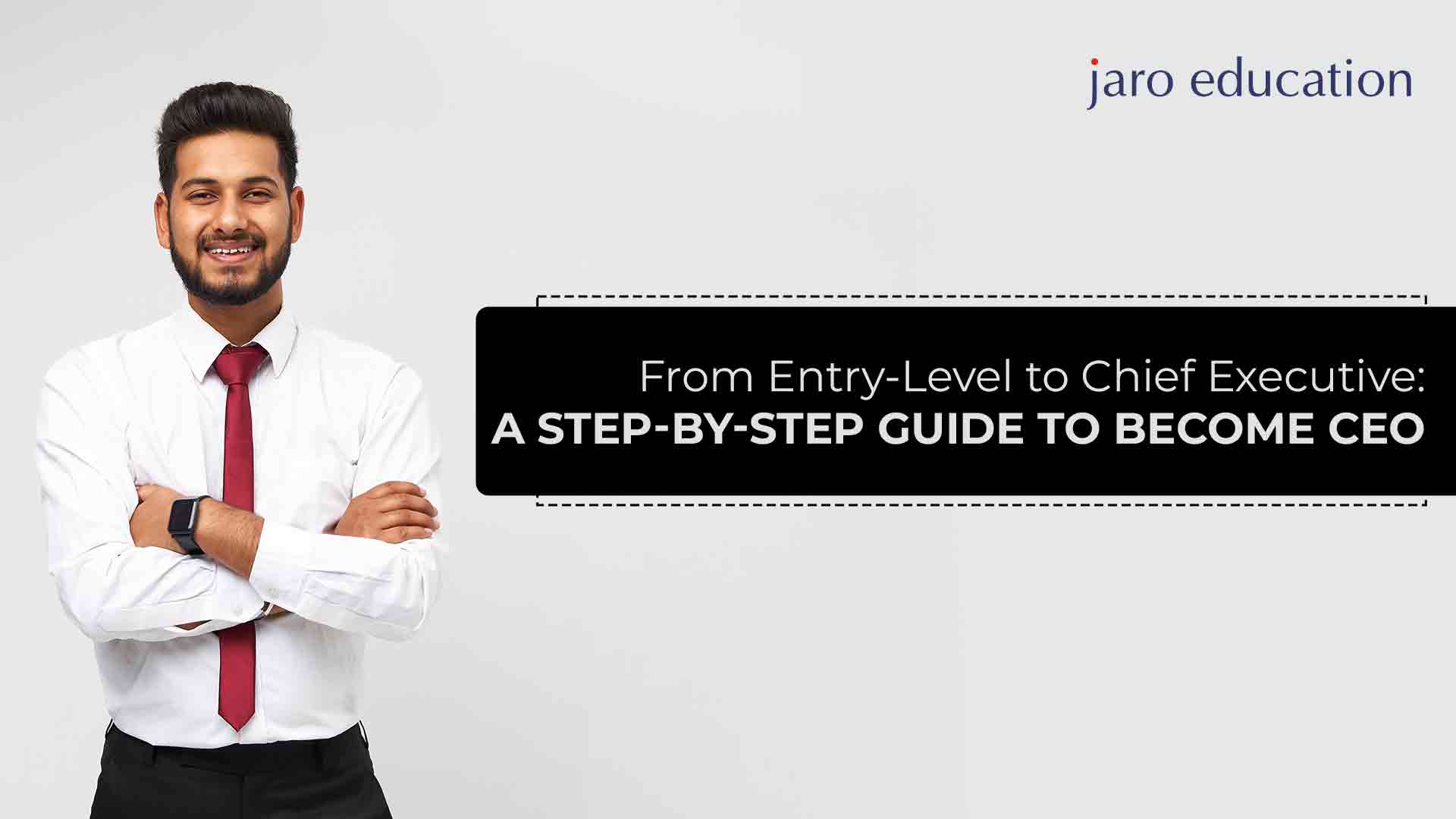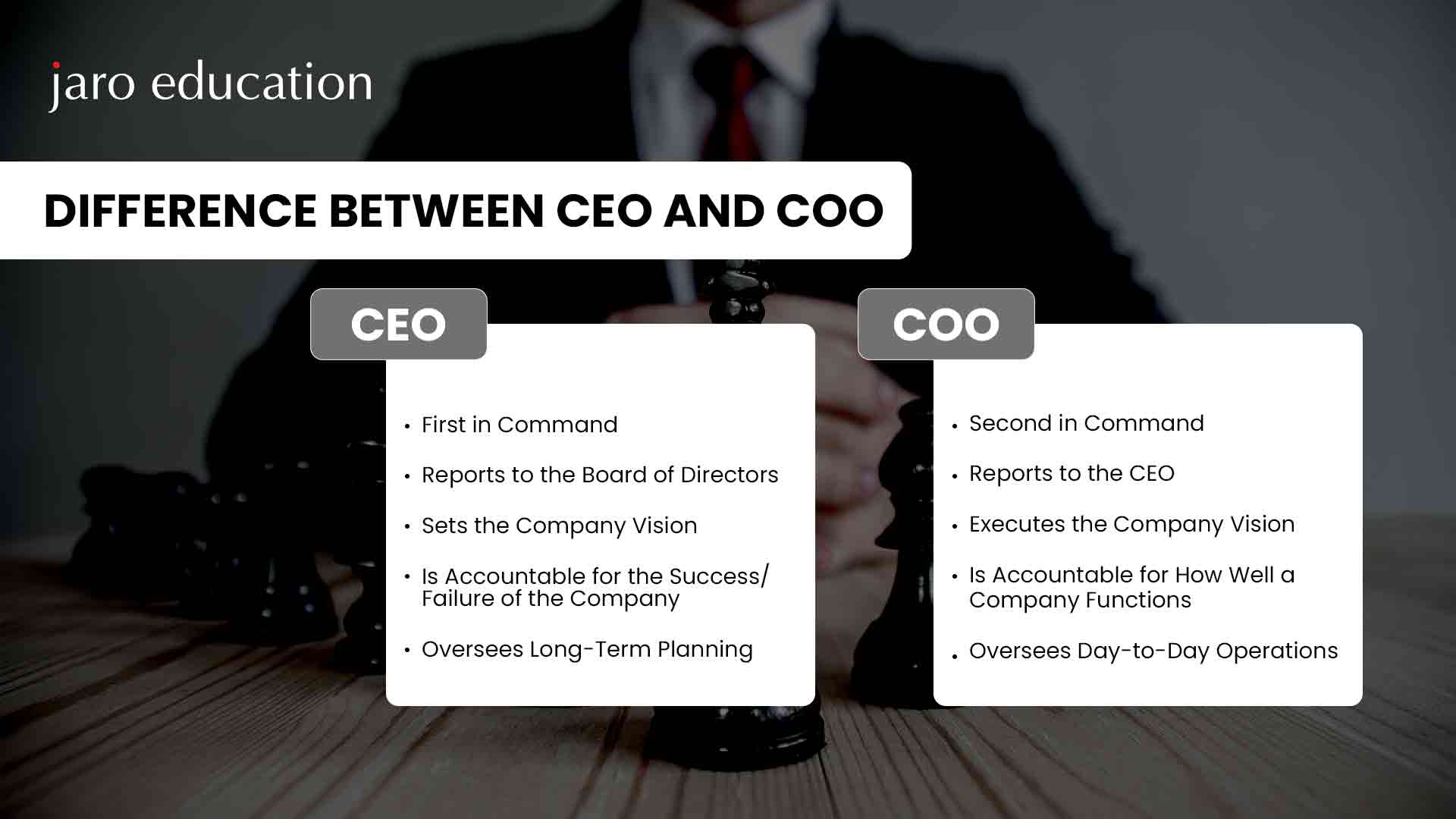
- jaro education
- 20, February 2024
- 2:30 pm
Aspiring to reach an organization’s highest leadership role as its Chief Executive Officer (CEO) is the pinnacle of career ambitions. Beyond prestige and perks, the CEO steers strategy, culture, financial health, and industry positioning. Companies trust CEOs with huge responsibilities – driving growth, optimizing operations, ensuring profitability, and managing various risks. Top CEOs earn well, with median pay packages at S&P 500 corporations now over $16.7 million in annual total compensation.
But what is a Chief Executive Officer and what are their roles? The chief executive officer (CEO) holds the top position in a company, overseeing operations and providing strategic leadership. As CEO, they set the vision and direction for the organization.
Table of Contents
The role of chief executive officer includes managing finances, resources, and talent while building a strong culture. CEOs make major corporate decisions, lead the executive team, and serve as the public face of the brand. With business expertise and management capabilities, they drive growth, innovation, and performance. The CEO is ultimately accountable for the company’s success in delivering shareholder value sustainably.
So are you inspired to reach the ladder of success by being a CEO? This blog provides a step-by-step guide to potential milestones aspiring CEOs should consider from early career through upper management to ascend into the ‘C-suite’ executive ranks. It charts a course across educational, experiential, and external positioning targets. The guide covers proven tips and frameworks for demonstrating multifaceted executive prowess mandatory for boards to bestow the CEO scepter.

*thebalancemoney.com
Steps to become a Chief Executive Officer
Here is a list of steps you should follow to become a successful CEO
1. Get a College Degree
If your goal is to reach the pinnacle of an organization and serve as its chief executive officer (CEO), the first step should be earning a strong educational foundation. While real-world experience, leadership capabilities, and business savvy matter greatly in rising to the CEO position and commanding an impressive chief executive officer salary, laying the groundwork with a college degree opens doors and provides critically important knowledge.
A bachelor’s degree demonstrates commitment, perseverance, and learning ability. Majoring in business, finance, technology, engineering, or other related fields builds hard skills and business acumen that directly translate to executive leadership roles demanding high pay. The coursework, research projects, and group collaborations shape analytical, problem-solving, communication, and decision-making proficiencies. The specific subject knowledge combined with generalized cognitive abilities lay the groundwork for understanding complex organizations, leading them toward profitability and growth.
While real-world experience matters greatly, almost all CEOs have a strong educational foundation. The bachelor’s degree experience cements abilities to learn quickly, make decisions under uncertainty, and navigate complex situations – all must-have competencies on the chief executive career track in today’s turbulent business climate.
CEO pay scales correlate with company size, profitability, and stock growth. While the median CEO makes around $100,090 annually, according to Bureau of Labor Statistics reports. And compensation goes up every year with strong corporate performance. A degree sets the stage for the skills and connections that ultimately drive qualified candidates into CEO openings and some of the most lucrative ones.
2. Gain Early Work Experience
After earning a college degree, the next critical step for becoming a successful chief executive officer (CEO) commanding a high chief executive officer salary is getting early work experience. Entry-level jobs and internships in your targeted field provide hands-on knowledge and start building the proficiencies expected of high-ranking business leaders and executives.
Look for opportunities at respected companies related to your industry interests. Finance, technology, healthcare, and engineering are typical pathways. Seek roles that offer formal training programs, mentorship arrangements, and exposure to cross-departmental functions. This builds business acumen rapidly. Embrace stretch assignments and rotations outside your job description to demonstrate ambition.
Early work experiences bolster technical capabilities while revealing personal work and leadership styles. This self-awareness allows adapting approaches to situations and personalities as you manage complex organizations. Developing these “soft skills” leads to rapid promotion from individual contributor roles through middle management to executive leadership.
At mid-size and larger firms, the pathway to CEO and associated lucrative salary packages typically involves reaching VP or SVP levels before joining the C-suite. This requires progressively advancing into roles with P&L ownership, direct reports, and exposure to boards of directors. Early work experiences lay this foundation for showcasing accountability and leadership talents that board members seek in new CEOs.
3. Develop Technical Skills
While strong leadership talents are essential for aspiring chief executives, mastering select technical capabilities can fast-track careers toward chief officer roles commanding million-dollar chief executive officer salaries.
- Finance – Financial insight, forecasting, capital allocation, and M&A deal expertise allow strategic decision-making based on numbers and drive profitability. Pursue CPAs or CFAs.
- Technology – As products and operations digitize, overseeing disruptive tech integration and cyber risks is paramount. Learning coding, AI/ML, and platforms sharpen tech literacy.
- Analytics – Data analytics fuels dynamic planning and growth opportunities. Gaining stats/calculus skills and SQL/Tableau tools enables insights from trends and metrics.
- Marketing – Brand messaging, campaign analytics, and omnichannel customer experience optimization are CEO-level priorities. Digital marketing courses build these toolkits.
Hands-on program management is also vital for
- Overseeing complex initiatives with integrated planning, budgeting, and talent coordination trains C-suite competencies.
- Analyzing progress metrics, quickly addressing variances, and managing stakeholders are transferable execution skills.
- Earning PMP or Lean Six Sigma credentials signals delivery discipline and excellence.
Beyond domain expertise, soft skills are essential for inspiring organizations
- Communications courses hone messaging and executive presence to convey vision passionately to all stakeholders.
- Psychology and organizational behavior classes teach how to motivate teams, avoid bias, and resolve conflicts.
- International business opportunities prioritize cultural awareness and a global mindset.
By complementing leadership talents with targeted technical skills and soft competencies, aspiring executives can amplify their strategic impact and accelerate their ascent to chief officer roles.
4. Build Your Network
They say, “It’s not what you know, it’s who you know.” This adage rings very true on the path to rising into a multi-million dollar chief executive officer salary CEO role. Building a robust professional network accelerates career progression by providing visibility to opportunities, insights from experiences, and influence with decision-makers.
Start connecting early in college through professors, clubs, and classmates. Actively maintain these relationships through social media and alumni groups. Stay abreast of contemporaries landing executive roles you aspire towards. Their journey gives you insight into priority experiences and capabilities for certain industries and companies.
Through each job rotation, seek senior management as mentors. Develop trust through project performance and genuine curiosity about their career steps and leadership approach. Maintain dialogue through job changes. As they progress, they can provide intelligence on emerging high-potential openings and submit their credentials.
Develop lateral peer networks across functions like Marketing, Finance, and Tech. With that, collaborate to drive enterprise initiatives, developing wide-ranging business intellect.
5. Take on Leadership Roles
Beyond educational and experiential credentials, strategically stepping into leadership roles accelerates readiness for the chief executive office and multi-million dollar salary packages.
Volunteering oversees extra projects, and teams signal ambition and ability to handle more responsibility. This initiative earns trust to direct people and operations. Chairing ERGs exhibits inclusivity, supporting enterprise talent and culture. Leading integration task forces fuse perspectives managing strategic priorities.
Here are the ways through which you can manage leadership roles successfully:
Seeking officer roles in professional associations provides external leadership development
This involves
- Setting a vision advocating for industry advancement and legal/regulatory influence.
- Directing programs, conferences, and communications for member enrichment.
Managing outsourced vendor relationships demonstrates the ability to cultivate value-add partnerships
- Balancing cooperation and negotiation to maximize flexibility, cost, quality, and innovation.
- Handling conflicts, disruptions, and logistical complexity develops CEO-equivalent crisis leadership.
Owning P&L accountability, even for individual business lines, establishes commercial acumen
- Optimizing budget tradeoffs between growth investments, cost management, and risk mitigation.
At mid-size companies, the COO chair frequently ascends to the CEO role when stipulating a salary package for a chief executive officer. Substantiated leadership expanding skills make a clear case to be appointed over external recruits.

6. Obtain Advanced Education
While hands-on leadership experience fuels candidacy for elite chief executive officer roles and salaries, rising executives should also consider augmenting academic pedigree with a Master’s or specialty graduate degree to catapult readiness for the CEO chair. Business administration programs, such as an executive MBA, are common stepping stones used by VP-level leaders aspiring to the C-suite. The contemporary strategic planning and operations playbooks taught enable large enterprise oversight. Understanding adjacent domain implications – technologies, globalization, regulations, sustainability – allows directing interdisciplinary objectives vital for CEOs.
Education like a Master’s in Management deepen financial operations fluency beyond undergraduate accounting courses. Expert-level financial engineering and investment optimization empower the execution of growth strategies and capitalizing markets. A CFA certification demonstrates this specialized quantitative prowess to Boards and shareholders.
For technology-centric sectors, pursue a specialized Master’s in Information Systems, Cybersecurity, or Software Development. Grounding executive decisions in technical depth and fluency increases authority when guiding vision and resources, prioritizing product innovation, and IP protection, which is essential for tech sector viability.
Legal concentrations, including a Master of Law, bolsters acumen in managing increased regulatory constraints across all industries – employment, data privacy, and environmental impact. It strengthens the license to operate amid greater public scrutiny of the negative impacts of business externalities.
7. Become an Expert in Your Field
Rising into elite chief executive officer roles also requires establishing subject matter expertise within your industry and specialization. This translates to authority directing strategy and operations as an insider and visionary.
Gain notoriety by publishing articles in trade journals and broader business press about trends, innovations, or case results in your functional domain and industry. Volunteer as a source of media coverage. Speaking at high-profile conferences also earns visibility as a thought leader.
Pursue advisory roles on technical councils, economic forums, and industry associations. Providing guidance based on evidence-based projections and creative concepts demonstrates strategic wisdom and foresight. It cements its reputation as both a practitioner and future-focused guide.
Teach courses at MBA programs or provide in-house training seminars. Academics value real-world insights to equip graduates. Sharpening communication to simplify complex themes exhibits the ability to inspire teams by connecting specialization to competitive advantage.
Obtaining patents and other intellectual property protection provides external validation of cutting-edge solutions that fuel business growth. It affirms that technology-driven companies prioritize elite innovation talents in chief executive officers offering substantial salary and stock incentives.
8. Take Smart Risks
While steady leaders deliver predictable results, CEOs ascending to steer companies paying multi-million dollar chief executive officer salaries often strategically take smart risks, bringing breakthrough advances but manageable downsides. They achieve this by:
- Volunteering for stretch assignments in functions or locations requiring big-picture thinking or creative problem-solving under pressure without obvious solutions.
- Spearheading pilots of emerging technologies or processes promising productivity leaps despite infrastructure gaps and behavioural resistance risks.
- Pursuing roles overseas in rapidly expanding markets involving cultural unfamiliarity, policy uncertainties, and organizational mismatches.
Besides the above-mentioned ways, you can also take the following initiatives to nullify risks and demonstrate the ideal traits of a CEO. They are as follows:
Calculated risks demonstrate courage and potential, even if initiatives underperform
- Boards and investors value innovation attempts and tolerate honest failures, allowing course correction.
- The skills honed in risk-taking roles reveal CEO-grade strategic thinking, executive presence, and change leadership.
Mitigate risks by defining key milestones and measures to quickly assess viability
- Seek external advisors like analysts, academics, and consultants to pressure test assumptions.
- Assign specialized project talent freed up from daily operations and inject new thinking.
- Secure executive sponsorship to champion initiatives if results start materializing.
Chance favors the prepared mind. Eminent 18th-century scientist Louis Pasteur famously stated this truth, noting that insight often emerges unexpectedly from intense preparation. Pursuing uncertain but promising concepts linked to corporate strategy fast tracks leadership development essential to climb into those coveted corner chief executive officer offices with visionary outlooks and noble risk-taking.
9. Develop Your Brand
Beyond credentials, experience, and expertise, succeeding in the chief executive suite and earning an elite officer salary requires nurturing a distinctive leadership brand that spotlights your values and vision. This personal proposition should permeate networks, presentations, and interviews, etching your identity into the memories of key stakeholders who can influence CEO appointments.
Define your style reflecting authentic beliefs but tailored for the CEO shortlist. Exhibit evolved thinking around profit with higher purposes like customer welfare, community betterment, sustainability progress, or staff enrichment. These passions attract support. Demonstrate grit, overcoming early career challenges through self-improvement. Boards admire perseverance, signaling future persistence through adversity.
Incorporate unique interests like sports, travel, or hobbies to distinguish your brand. Eclectic backgrounds cultivate creative instincts that solve complex problems. A flair for writing or oratory points to eloquent messaging skills. Scientific prowess conveys analytical rigor. These talents help connect with key audiences as a CEO.
Showcase social conscience volunteering or personal philanthropy benefiting social good causes. But ensure these community initiatives align with corporate values, too. Empathy telegraphs the duty of care for all stakeholders. Yet the strategy affinities affirm shareholder priorities are retaining central focus.
The branding communication across campaigns and channels should consistently showcase your cultural fit, strategic perspective, and leadership ethos – but with some signature surprises that make you memorable amid a sea of qualified CEO aspirants.
10. Plot Your Route to the Top
Reaching the position of chief executive officer requires meticulously planning rotations and risks to develop wide executive skill sets proven across diverse leadership trials. Here are the following steps you need to follow to reach the top of your company’s hierarchy:
Setting proper milestones and analysing results
- Chart 2-3 year milestones across marketing, technology, and operational domains directing lines of business demonstrating cross-discipline leadership.
- Seek international assignments, growing markets, and M&A integrations to exhibit strategic scale and cultural fluency.
- Capture measurable outcome improvements for each role, quantifying leadership impact – cost savings, revenue growth, and market share upticks.
Target visible stretches that spur growth
- Fix underperforming business lines by restructuring teams and overhauling processes, building turnaround talents.
- Lead post-merger integrations, reconciling cultures and rationalizing functions, accelerating unified growth.
- Head special initiatives like ESG, innovation, and workplace advancement, cementing CEO-worthy vision and setting industry agenda.
Address skill gaps through selective training programs
- Seek board observer roles to absorb governing dynamics and cultivate director relationships.
- Enroll in executive courses studying strategy, financial engineering, and talent optimization.
- Hire executive coaches and mentors providing guidance tailored to personal growth areas.
Conclusion
Reaching the pinnacle of the corporate ladder to become a chief executive officer (CEO) is an arduous yet rewarding undertaking requiring immense dedication across educational, experiential, and self-branding dimensions over a career. While each leader’s journey to the CEO suite is unique, this strategic roadmap charts markers – from early academic and entry-level foundations to mid-career skill-building through upper management roles exhibiting enterprise-wide leadership.
If you are aiming for the elite chief executive officer, you must augment your real-world experience with high-level academics to cement strategic insights. Dayananda Sagar University’s cutting-edge Executive MBA builds multifaceted business acumen, preparing visionaries to steer complex global enterprises. Immerse in contemporary operational frameworks directing integrated marketing, finance, technology, and talent priorities mandatory for C-suite roles. To know more, contact Jaro Education.









